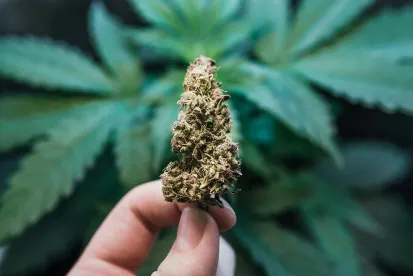Hemp product producers and sellers must consider a large number of legal and regulatory compliance risks each day.
Are their inputs and plant material coming from legally compliant sources? Are their products, packaging, and sales and marketing activities compliant with federal laws and regulations, like the Federal Food, Drug & Cosmetic Act and the Federal Trade Commission Act? And are those same products, packaging, and sales and marketing activities compliant with state-level laws in each jurisdiction where the company operates or sells goods? Existing regulatory uncertainties for the industry as a whole and the patchwork of state-level laws developing around the country make it difficult for anyone to manage risk from day-to-day. And as new product trends develop, often forcing lawmakers and regulators to play catch-up with the industry, it can become even more difficult for hemp product producers and sellers to manage their risk and compliance obligations.
Enter Delta-8 THC
Delta-8 tetrahydrocannabinol ("Δ-8 THC") is a driving force in the hemp-derived product market today. Δ-8 THC product categories have, in many cases, kept hemp product retailers financially afloat through the COVID-19 pandemic. Many consumers seem to prefer Δ-8 THC products to other categories (including CBD products), as anecdotally evidenced by the recent proliferation of Δ-8 THC retail sales. Clearly, from the standpoint of economic and consumer demand, Δ-8 THC has a place in the market. But it does not enjoy universal support. A quick Google search for the term (or any variation thereof) yields a long list of news articles and opinion pieces about Δ-8 THC and its growing popularity. Some positively tout its anecdotal benefits, effects, and growing consumer demand. Others, like recent advisory warnings from the FDA and CDC, raise concerns over the potential safety and long-term effects of Δ-8 THC use by consumers.
The objective reality is that Δ-8 THC product producers and sellers face heightened legal, business, and regulatory risks by participating in the market.
The Law is Not Settled
Δ-8 THC occurs naturally in the cannabis plant in very small amounts. At those low levels, it is not financially or commercially feasible to extract naturally occurring Δ-8 THC from the plant itself for direct use in product formulation and manufacturing. Instead, most (or perhaps all?) of the Δ-8 THC products on the market today are formulated with inputs that are derived from the conversion of CBD into Δ-8 THC using chemical agents in a laboratory setting. That process sets the stage for much of the debate and unanswered questions circling Δ-8 THC today.
At least fifteen states have already adopted laws or rules that prohibit or seek to prohibit the sale of Δ-8 THC products within their borders, with more considering similar proposals. Other states have noticeably chosen not to prohibit or address the regulation of Δ-8 THC within their borders thus far. But lawmakers and regulators are becoming increasingly more educated and aware of Δ-8 THC and similar "lab-processed" or "lab-created" products. With increased state-level activity, and increased visibility of Δ-8 THC in the news, it is beginning to feel – to us – as though specific governmental regulation of the product category is inevitable. No one knows when, or exactly what those regulations will look like, but companies making or selling Δ-8 THC products should be prepared for that outcome.
The "Synthetic" Cannabinoid Conundrum
We often hear and read claims by industry participants that Δ-8 THC is "federally legal." That claim is misleading. It is true that federal law today does not explicitly ban or prohibit the sale or possession of hemp-derived Δ-8 THC. But there is a nuanced, and important, difference in those statements.
Tetrahydrocannabinols ("THC") remain Schedule I controlled substances. But the 2018 Farm Bill de-scheduled both hemp and THC found in hemp. The U.S. Drug Enforcement Administration ("DEA") responded to that de-scheduling by publishing its Interim Final Rule on Implementation of the Agriculture Improvement Act of 2018 ("IFR"). The DEA contends that it issued the IFR to codify statutory amendments to the Controlled Substances Act made by the 2018 Farm Bill regarding the scope of its regulatory controls over marijuana (or cannabis, as we like to call it in the 21st Century), THC, and other cannabis-related constituents. The IFR took immediate effect on August 21, 2020.
Among other things, the IFR contends that products containing THC that naturally occur in hemp are not controlled substances if the products at issue contain 0.3% or less Δ-9 THC by dry weight. But this definition is not limited to Δ-9 THC only. Instead, it broadly refers to THC as a category of cannabinoids and presumably also includes Δ-8 THC. So, logically, if a product contains different forms of naturally occurring THC, and the overall Δ-9 THC content is 0.3% or less by dry weight, then the product should qualify as "hemp" under the 2018 Farm Bill and should not be considered a controlled substance.
But the IFR does not stop there. Instead, it also implies that if a product or ingredient contains any "synthetically derived" THC, it will be viewed by the DEA as a Schedule I controlled substance regardless of the source material from which it was derived (i.e., hemp) and regardless of its Δ-9 THC concentration. Again, the reference to "synthetically derived" THC is not limited to Δ-9 THC only. Instead, it broadly refers to THC as a category of cannabinoids and presumably also includes Δ-8 THC.
Federal law does not provide clear definitions for the terms "synthetic" or "synthetically derived," and, to our knowledge, those definitions have not yet been directly analyzed, settled, or determined by the courts. So, uncertainty remains as to when certain forms of THC will qualify as naturally occurring constituents of the cannabis plant (i.e., not a controlled substance) vs. synthetically derived (i.e., a controlled substance). It is unclear as a matter of law today whether or not forms of THC created by isomerization or other chemical reaction qualify as controlled substances, including, for example, Δ-8 THC that is created by converting hemp-derived CBD through the use of a catalyst. But it does seem clear that the DEA believes this to be the case, and companies participating in the Δ-8 THC market should be very aware of that risk.
Other Important Considerations
While the synthetic cannabinoid conversation may still be open to reasonable disagreements, other legal risk factors exist for the Δ-8 THC market. The Federal Analogue Act is not often acknowledged or widely discussed by industry participants, but it must also be considered when assessing the risk associated with Δ-8 THC activities. The Federal Analogue Act generally defines a "controlled substance analogue" as any substance:
(i) the chemical structure of which is substantially similar to the chemical structure of a Schedule I or Schedule II controlled substance;
(ii) which has a stimulant, depressant, or hallucinogenic effect on the central nervous system that is substantially similar to or greater than the stimulant, depressant, or hallucinogenic effect on the central nervous system of a Schedule I or Schedule II controlled substance; or,
(iii) with respect to a particular person, is represented or intended to have a stimulant, depressant, or hallucinogenic effect on the central nervous system that is substantially similar to or greater than the stimulant, depressant, or hallucinogenic effect on the central nervous system of a Schedule I or Schedule II controlled substance.
Suppose a product qualifies as a "controlled substance analogue," and it is intended for human consumption. In that case, the Federal Analogue Act mandates that it be treated as a Schedule I controlled substance. Again, to our knowledge, there are no judicial opinions that explicitly interpret the Federal Analogue Act to mean that Δ-8 THC is a "controlled substance analogue" and, thus, a Schedule I controlled substance. But the existence of this federal law creates a real risk for the industry when coupled with the method by which most (or all?) Δ-8 THC is created today, and the effects Δ-8 THC has or is marketed to have on the human body when consumed.
What the Industry Can Do Today
No one in the industry wants to see a consumer get seriously sick, injured, or worse from consuming or using a Δ-8 THC product. A public health crisis tied to Δ-8 THC specifically, or tied to hemp products generally, would set the industry back substantially with both consumers and governmental agents. It would also likely lead to reactionary and stifling laws, policies, and regulations for the hemp industry in general. We never need to reach that point as an industry.
So what can Δ-8 THC product producers and sellers do to manage and mitigate their risk and liability exposure responsibly?
-
Be smart. Self-regulate. Operate with the "Golden Rule" as your guiding light.
-
Responsibly and accurately label and package your products.
-
Do not make false or misleading claims about your products, health or medical-related claims, or other claims about your products and the substances they contain that are not factually accurate and verifiable.
-
Obtain your product materials and inputs from reliable, lawful sources.
-
Ensure that you and your suppliers and vendors follow applicable state and federal laws and rules, including those centered on good manufacturing practices.
-
Do not sell Δ-8 THC or any other intoxicating products to consumers under the age of 21.
-
Responsibly educate customers on the effects your products may have on them.
-
Limit your products' concentration and serving size to avoid "over serving" unwary or uneducated consumers. Does anyone really need a 100mg gummy?
-
Use child-resistant packaging.
-
Have standard operating procedures and track-and-trace policies that allow you to appropriately respond to customer complaints, product liability, and product recall issues.
-
Insure your risk, and require your vendors and suppliers to have appropriate insurance coverage as well.
-
Conduct lot or batch-specific testing of your products. Test your inputs and final products extensively, not just for Δ-9 THC content.
-
Use written business agreements. If drafted appropriately, you may be able to contractually shift or disclaim certain risks and liabilities facing your business. For example, you may be able to disclaim express or implied warranties under the Uniform Commercial Code, limit or disclaim certain types and amounts of damages that may flow from a breach of your contracts, or obtain appropriate indemnification and hold harmless agreements from your business partners in the event they make a mistake and expose you to liability.
Utilizing these practices will not eliminate the significant business, legal, and regulatory risks associated with Δ-8 THC business operations. But they will help to manage and mitigate those issues, and overall, lead to a more responsible platform of participation within the industry.





 />i
/>i

